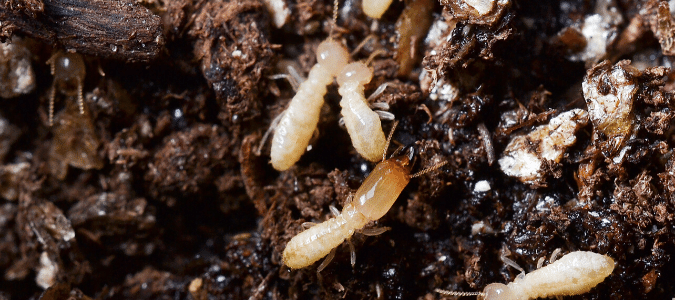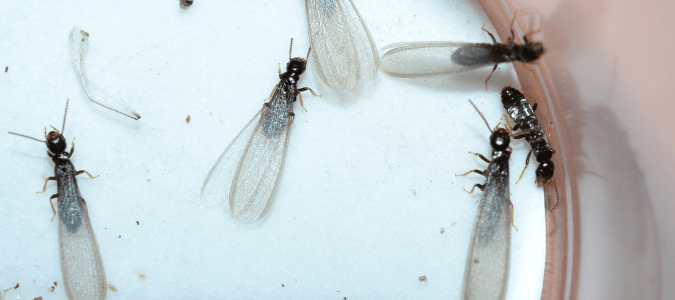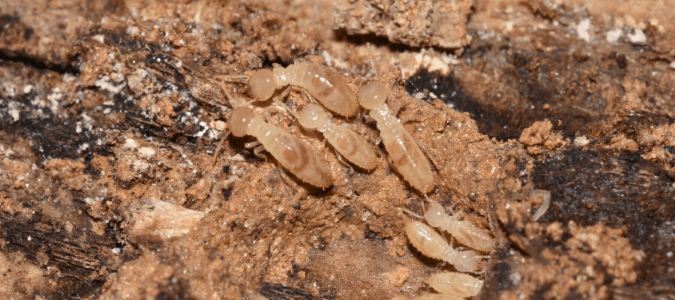Are termites taking up residence on your property? There are several places where termites can hide outdoors, including in your garden and flower beds. One substance that termites have been known to infest is mulch. Thankfully, there are types of mulch that you can use to help avoid termites.
If you suspect that a termite colony is taking up residence on your property or inside your house, call a professional pest control service to implement an effective treatment.
Choosing the Right Mulch to Avoid Termites
Mulching your flower and garden beds is a great way to keep your yard healthy and beautiful. However, it can become frustrating when you find termites in your mulch. These pests can make their way from your yard to your house and cause severe and costly structural damage.
Homeowners always want to know the best mulch to avoid termites, but the truth is that mulch does not inherently attract termites. Instead, termites are often found in mulch because it provides them with a moist place to live and a food source.
One of the most common types of termites, subterranean termites, prefer damp habitats, which is why mulch is appealing to them. They also like to eat decaying wood, leaves and grass, which can be found in mulch.
The good news is that some types of mulch are less attractive to termites than others.
Types of Mulch
The best mulch to use to avoid termites is cedar mulch. Termites don’t particularly like cedar. However, if they must, they will eat it, so it is not guaranteed to keep these pests away. Another option is cypress heartwood mulch, which contains anti-fungal properties that can keep termites and other pests away.
Mulch made from redwood may also be less attractive to termites; however, it does not last as long as cedar mulch. It is a softwood mulch, which means it breaks down and decays faster than hardwood mulch.
For another option, you can try melaleuca mulch. Also known as tea tree mulch, it contains natural tea tree oils that may help repel termites. It is also a hardwood mulch.
Lastly, there are treated mulch and inorganic mulch options that can help keep termites out of your yard.
It is important to note that termites will eat any source of cellulose and all types of wood and organic materials contain cellulose. Even if some types of wood have defensive properties, most of that protection is lost when the materials are ground down into mulch. You cannot deter termites just by using a certain type of mulch.
If termites have already made a home in your garden, a pest control professional can treat them. Termites can cause costly damage to your home and property, so do not wait to contact a professional pest control service.
Why Do I See Termite Wings Fall Off?
Some types of termites, called swarmer termites, do have wings that they shed during their lifecycle. If you see discarded wings in your home, it is because a swarm of termites was on the move.
There are several types of termites in one termite colony, including swarmer termites, worker termites and soldier termites. Swarmer termites are the only type that reproduces. When their colony reaches maturity, swarmer termites leave the nest to mate and start new colonies. For subterranean termites, this process usually happens in the springtime.
If you are home during a swarm, you will notice these pests flying around and heading toward windows and other sources of light. If you aren’t home during a swarm you may notice shed wings in a room of your home. Once swarmer termites meet a mate, they shed their wings. This is why you may see their discarded wings on your windowsills or floors.
If you find discarded termite wings in your home, it is a sign that there is an infestation nearby. Swarmer termites have two pairs of wings that are gray, pale or translucent looking. Their wings are double the size of their bodies, which range from one-fourth to three-eighths of an inch long.
Swarmer Termites Versus Worker Termites
Besides their wings, there are a few other ways to tell swarmer termites apart from worker or soldier termites. For example, swarmer termites can have black, brown, tan or beige bodies. Worker termites have pale white bodies, and they are smaller than swarmer termites.
It is more common for swarmer termites to be confused with flying ants than other types of termites. However, you can tell them apart by their wing size, body shape and antennas.
Swarmer termites have two pairs of wings that are the same size while flying ants have two pairs that are different sizes. Flying ant wings are also a darker brown compared to swarmer termites’ pale wings. Flying ants have pinched waists and curved antennas, while swarmer termites have squared-off bodies and straight antennas.
If you aren’t sure whether you are seeing swarmer termites or flying ants, collect a few wings to show to a professional that has experience with termite control. Remember that swarmer termites indicate that a colony of termites is nearby, so you do not want to hesitate to enlist professional help.
Do Termites Eat Clothes?
Termites are known for eating wood and causing severe structural damage. However, wood is not the only thing that termites feast on. While it is not their first choice of a meal, termites will eat clothes and fabrics. Termites eat cellulose, a plant-based material that is present in wood and other organic materials. It is also present in certain fabrics, which is why termites are sometimes drawn to clothes. Natural fabrics like linen, hemp and cotton are abundant in cellulose.
There is also cellulose in books and wallpaper, so an advanced termite infestation may start eating away at those items too.
You can tell if termites have been eating your clothes by spotting holes in the fabric. However, other pests like to eat clothing, such as moths and silverfish.
As far as clothing goes, it’s also important to note that subterranean termites have to maintain a moist environment. This means it is less likely for a subterranean termite to eat clothes that you keep in your dresser. However, there are other circumstances where it may be easier for termites to access clothing items. For example, termites may chew through clothes in cardboard boxes that have been left on the floor of a garage.
If you notice that your clothes have holes, but you aren’t sure what type of pest is the culprit, a pest control specialist can get to the bottom of it.
ABC Helps Homeowners Control Termites
Given the potential damage termites can cause, you don’t want to risk trying home remedies for termites that might not work. The experienced pest control specialists at ABC Home & Commercial Services know exactly where these pests like to hide. We can create a customized pest control plan for your home that can treat the entire colony of termites. In addition, we offer an ongoing termite monitoring program that can help catch potential termite problems early.



